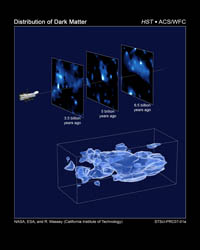Imagine the Universe News - 23 January 2007
Hubble Maps the Cosmic Web of "Clumpy" Dark Matter in 3-D
| 23 January 2007 |
 Click image to enlarge The top "sliced" image shows how dark matter evolved from 6.5 billion to 3.5 billion years ago. The bottom image shows dark matter "clumping" together over time confirming theories of how structure formed in our evolving universe. (Credit: NASA, ESA, CalTech) |
An international team of astronomers using NASA's Hubble Space Telescope has created the first three-dimensional map of the large-scale distribution of dark matter in the universe.
Dark matter is an invisible form of matter whose total mass in the universe is more than five times that of "normal" matter (i.e., atoms). The nature of dark matter is still unknown. Its presence in the universe is inferred from its current influence within galaxies and clusters of galaxies, and the gravitational effect it has had on the evolution of structure in the universe. The first direct detection of dark matter was made this past year through observations of the Bullet Cluster of galaxies.
This new map provides the best evidence to date that normal matter, largely in the form of galaxies, accumulates along the densest concentrations of dark matter. The map reveals a loose network of filaments that grew over time and intersect in massive structures at the locations of clusters of galaxies.
The map stretches halfway back to the beginning of the universe and shows how dark matter has grown increasingly "clumpy" as it collapses under gravity.
The dark matter map was constructed by measuring the shapes of half a million faraway galaxies. To reach Hubble, the light of the galaxies traveled through intervening dark matter. The dark matter deflected the light slightly as it traveled through space. Researchers used the observed, subtle distortion of the galaxies' shapes to reconstruct the distribution of intervening mass along Hubble's line of sight, a method called "weak gravitational lensing."
For astronomers, the challenge of mapping dark matter in the universe has been similar to mapping a city from nighttime aerial snapshots showing only streetlights. Dark matter is invisible, so only the luminous galaxies can be seen directly. These new map images are equivalent to seeing a city, its suburbs and country roads in daylight for the first time. Major arteries and intersections become evident, and a variety of neighborhoods are visible.
 Click image to enlarge These two false-color images compare the distribution of normal matter (red, left) with dark matter (blue, right) in the universe. The brightness of clumps corresponds to the density of mass. The comparison will provide insight on how structure formed in the evolving universe under the relentless pull of gravity. (Credit: NASA, ESA, CalTech) |
Mapping dark matter's distribution in space and time is fundamental to understanding how galaxies grew and clustered over billions of years. Tracing the growth of clustering in dark matter may eventually also shed light on dark energy, a repulsive form of gravity that would have influenced how dark matter clumps.
The research results appeared online in the journal Nature on Jan 7, and were presented at the 209th meeting of the American Astronomical Society in Seattle, Wash., by Richard Massey and Nick Scoville. Both researchers are from the California Institute of Technology, Pasadena, Calif.
"It's reassuring how well our map confirms the standard theories for structure formation," said Massey. He calls dark matter the "scaffolding" inside of which stars and galaxies have been assembled over billions of years.
Researchers created the map using the Hubble's largest survey to date of the universe, the Cosmic Evolution Survey, otherwise known as COSMOS. The survey covers an area of sky nine times the area of the Earth's moon. This allows for the large-scale filamentary structure of dark matter to be evident. To add 3-D distance information, the Hubble observations were combined with multicolor data from powerful ground-based telescopes, Europe's Very Large Telescope in Chile, Japan's Subaru telescope in Hawaii, the U.S.'s Very Large Array radio telescope, New Mexico, as well as the European Space Agency's orbiting XMM-Newton X-ray telescope.
The Hubble Space Telescope is a project of international cooperation between NASA and the European Space Agency. The Space Telescope Science Institute, Baltimore, conducts Hubble science operations. The Institute is operated for NASA by the Association of Universities for Research in Astronomy, Inc., Washington.

